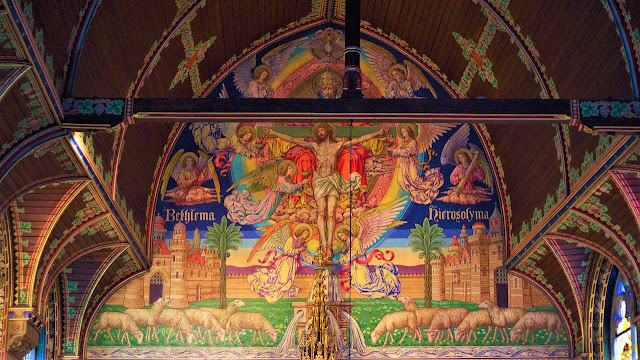 |
Basilica of the Holy Blood in Bruges, The Trinity, fresco above the high altar | René de Cramer
Wikipedia |
H/T David Clayton
The true work of art is but a shadow of the divine perfection.
- Michelangelo
Gart is the term that a former philosophy professor of mine imparted to us students to describe something pretending to be art. Technically speaking, there is no such thing as bad art. Art, by definition, describes something - is something - that belongs in the category of excellence and the sublime. Art epitomizes the best of something. Art embodies the true, the good and the beautiful. Gart, on the other hand, is something less than art.
A determination of artistic merit does not depend on the popularity of a thing. Artistic merit is determined by the degree to which something epitomizes the true, the good and the beautiful. Merit can be intuited and/or deduced. One does not necessarily need a university degree to be able to recognize art. A trained intellect corrupted by attachments to base things is just as likely to ascribe merit to an ugly thing as an intellect mired in willful ignorance does not distinguish between art and pornography. Minds enamored in baseness and shallow thinking tend to admire the emperor's new clothes.
A few recent online articles tend to provoke the need for comparison and a refinement of taste. Taste - the ability to discern art. Taste manifests/is an ability to distinguish art from gart.
David Clayton, "an internationally acclaimed Catholic artist, teacher, and published writer on sacred art, liturgy, and culture," brings to our attention the work of Belgian artist René de Cramer. His article at NLM points us to an article by the Deacon Lawrence Klimecki about de Cramer.
At his website The Way of Beauty, Clayton also brings to our attention the work of Victor Vasnetsov.
Vasnetsov's and Cramer's works affirm transcendence, and invite the readers or viewers of such works into a communion with God. Can the same be said about the cartoonish works of the disgraced and excommunicated Jesuit Marko Ivan Rupnik?
Let us compare:
Rupnik and his Centro Aletti;
 |
| Screenshot | CA |
 |
| Screenshot | CA |
and Vasnetsov;
and Cramer.
One could suggest that Rupnik's work is intended for an era that requires simplicity whereby the viewer might more readily invest himself. Fair enough. However, like candy that satisfies for a moment and, if taken too much of, tends to rot teeth and expand waistlines, Rupnik's work does not require a serious investment, an investment of the imagination that, encountering the rich banquet of a Cramer or a Vasnetsov composition, is sated by a feast. A soul that exercises her capacity for beauty, goodness and truth becomes enabled to be enriched by the Holy Spirit, strengthened in virtue, and a cooperator in the charity of Christ.
Rupnik's works have figures with large eyes. The eyes are solid, opaque, and disturbingly vacant. The eyes of C-3PO convey more feeling than do Rupnik's eyes. Are we meant to find ourselves in those eyes? So much of human warmth and compassion is conveyed through the eyes. What of divine warmth? Again, Rupnik's work falls short of conveying mercy, divine or human.
Physician of my sin-sick soul,
To Thee I bring my case;
My raging malady control,
And heal me by Thy grace.
Text: John Newton | Tune: CONTEMPLATION
Perhaps Rupnik's inability to convey sympathy in his work and the hollowness of those eyes - his eyes? - reflects his inability to affirm the humanity of his associates and Rupnik's inability to empathize with his victims.
Revelations of late tend to confirm what E. Michael Jones wrote in Degenerate Moderns (Ignatius: 1993). In summary, Jones' insight is that modern art, like all art, is shaped by the biographies of its creators. Modern art is symptomatic of artists' perverse inclinations. There should be no surprise that toxic behaviours are motivated by modern influencers and their gart.
Is Rupnik's work akin to a paint-by-numbers composition? It may be that someone may be inspired to go further by learning to copy great works. Too often, however, objects constructed over the past fifty years or so - church interiors and exteriors - tend to entrench people in the comfortable and bland. Works that pretend to educate by providing childish renditions of august moments in human history tend to underestimate the human need for nuance as well as the human ability to comprehend and appreciate complexity. Rather than helping the worshipper to approach the Lord, the Giver, cheap compositions, like cheap religion, tend to enable sloth and attachment to the gifts. Gart tends to distract from rather than point to the Author of the true, the good and the beautiful. In Rupnik's work, we witness his caricature of the realities that yearn for a more fitting telling.
Art enables self transcendence and the abandonment of egoism; it liberates us from our narcissistic tendencies. Art is more than a demonstration of manual skill. It is a word loaned by the Word of God, a demonstration of effort configured to the will of God, a participation in the creative power of the Holy Spirit. Gart deadens the imagination and numbs the heart. Art nudges the conscience and soothes the sin-sick soul.






.jpg)





Comments
Post a Comment
Your comments will be appreciated and posted if 1) they are on topic and 2) preserve decorum.
Stand by your word.